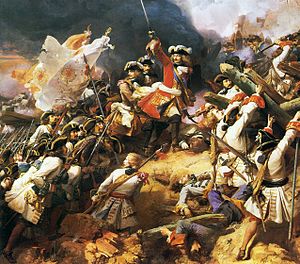French Royal Army (1652-1830)
The French Royal Army (French: Armée royale française) served the Bourbon kings beginning with Louis XIV and ending with Charles X with an interlude from 1792 until 1814, during the French Revolution and the reign of the Emperor Napoleon I. After a second, brief interlude when Napoleon returned from exile in 1815, the Royal Army was reinstated. Its service to the direct Bourbon line was finished when Charles X was overthrown in 1830 by the July Revolution.
When Louis XIV came to the French throne in 1661 he inherited a large but loosely organized force of about 70,000 men. Like the other European armies of the period it consisted of a mixture of mercenaries, guard units, local militias and levies conscripted only for specific campaigns and then disbanded. Organization, cohesion, training and equipment were generally of a low standard.
Under Louis' two Secretaries of War Michael Le Tellier and his son the Marquis de Louvois the Royal Army was recreated as a disciplined and professional force of permanent regiments under central control. Weapons, promotion, drill, uniforms and structure were improved or introduced and the army was nearly doubled in size. It became a model for the new "regimental" system that was to be imitated throughout Europe, and one of the most powerful in the world.
When Louis' father, Louis XIII, died, Anne of Austria, the queen, became regent. She and her chief minister, Cardinal Mazarin, ordered the arrest of legislative opponents, causing the enmity of many nobles and common citizens. When the bloody Thirty Years' War, in which France had sided with Protestant-governed countries against other Catholic nations in Europe, concluded, the Fronde civil war broke out and Mazarin was forced to flee.
...
Wikipedia


